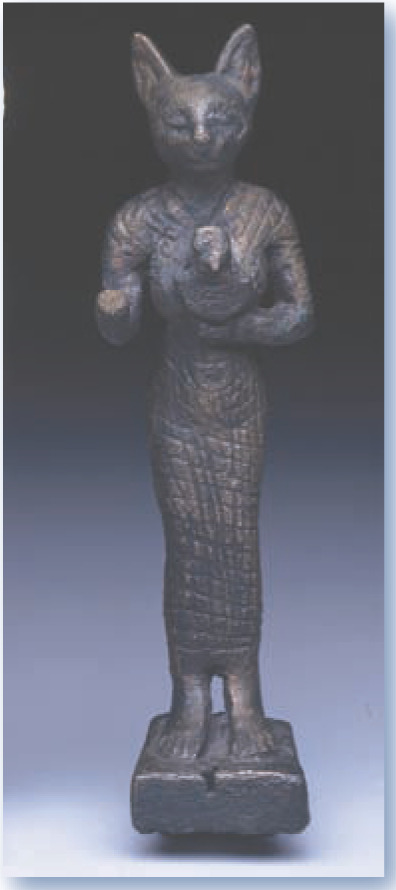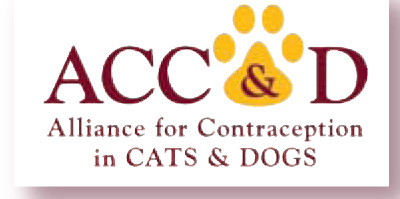One of the earliest Egyptian goddesses, Bast (later Bastet), is associated with both fertility and childbirth. Bast is usually depicted as a beautiful woman with the head of a domestic cat. That symbolism is no surprise. Cats are known for their ability to reproduce in their first year of life and to produce multiple litters a year. Like rabbits, they are one of a limited number of species whose ovulation is typically induced by mating, giving them quite an advantage for conception. Add their current popularity as pets, and the kind-heartedness of people who feed homeless cats, and feline population numbers can easily careen out of control.
For the individual cat, and at the population level, fertility control is likely the greatest aid in managing the health and welfare of the world’s pet cats, as well as feral cats that live in a wilder, more independent state. Currently, surgical sterilization is essentially the sole tool in the fertility control toolbox to achieve long-term (lifelong) control of breeding. While it is a vital tool, it is also one that, we believe, is unable to reach as widely as needed to keep up with the fecund feline. Furthermore, in many parts of the world where population control is needed there may not be trained veterinarians or resources to be able to undertake surgical sterilization.
As a result, the non-profit Alliance for Contraception in Cats & Dogs (ACC&D) serves to advance methods of non-surgical reproduction control to save the lives of more cats, expand options for pet owners, and improve the wellbeing of animals and communities worldwide. Part of our role is to increase awareness of and dialogue about current initiatives, and help pave a pathway to future products that meet the needs of veterinary practitioners and the clients, both human and feline, that they serve.
Given that, we are thrilled to partner with the Journal of Feline Medicine and Surgery on this Special Issue. It is fitting that this first-ever full issue of a veterinary journal on this topic should be the collaborative publication of AAFP and ISFM, the leading veterinary advocate organizations for cats across the world. We are most grateful to Andy Sparkes, Claire Bessant and Margaret Melling for their vision and mentorship on this project.
The 10 articles in this issue are authored by experts in the field and are, for the most part, review articles. Five cover specific contraceptives used to date for cats, or the limited array of sterilants and contraceptives being researched or used off-label in cats in the past decade. The emergence in 2008 of a USD$25 million prize and up to $50 million in grant funds has spurred more research than ever before, and in a number of novel areas. A glimpse into that new work is shared by the Director of Scientific Research for the Found Animals Foundation, the parent organization for this initiative: the Michelson Prize & Grants in Reproductive Biology.

Bast, generally thought of as the cat goddess, personified the playfulness, grace, affection and cunning of a cat. Courtesy of Penn Museum, image 152022
The requirements involved for a drug or vaccine affecting fertility to get regulatory approval in the US or EU is the focus of another article. It is an area that often comes up in the discussion about ‘how long will this take?’
Other articles in this Special Issue look at the context for a future in which a simple syringe could stand in for surgical tools to prevent unwanted litters. Attitudes of veterinarians, cat owners and breeders all influence the ability of new research to translate into tools for your practice. Researchers from the UK, Sweden and the USA collaborated to review studies of attitudes toward sterilization surgery and limited research on non-surgical options, along with some new primary research on the topic, and translate this into implications for future products.
A population biologist shares perspectives on how computer modeling and ways to better ‘count cats’ can aid projects to control the fertility of free-roaming cat populations. In another article, an initiative to create new visible methods to identify free-roaming cats takes us on a journey to prepare for a time when unowned, free-roaming and feral cats can be treated in the field without the full anesthesia necessary to tip the ear as a sign of sterility.
Practicing veterinarians are the respected authority on issues related to cat health, and can be leaders in tomorrow’s methods to advance it. We hope that this Special Issue will provide you with a strong resource to counsel your clients on today’s possibilities for non-surgical fertility control, as well as to play a leadership role as an early adopter of upcoming technologies in this emerging field.
I’d like to thank the editorial committee that worked hard on this issue: Valerie Benka, MS MPP; Amy Fischer, PhD; Cynthia Mills, DVM MPH; and Steve Zawistowski, PhD CAAB; the 12 authors or co-authors, and the 20 expert reviewers. Their passion for this topic and for feline health and welfare shows in this publication and beyond.
We are pleased to have partnered with ISFM on this very topic for a full day session at the 2015 ISFM European Congress in Porto, Portugal. Most authors in this Special Issue also presented at the Congress. Access the links to their recorded sessions at http://icatcare.org/vets/videos to learn more from the presenters at this ground-breaking event.
Joyce Briggs, MS
President, ACC&D



